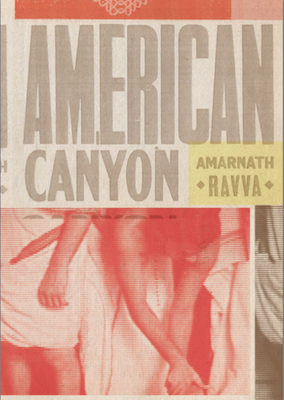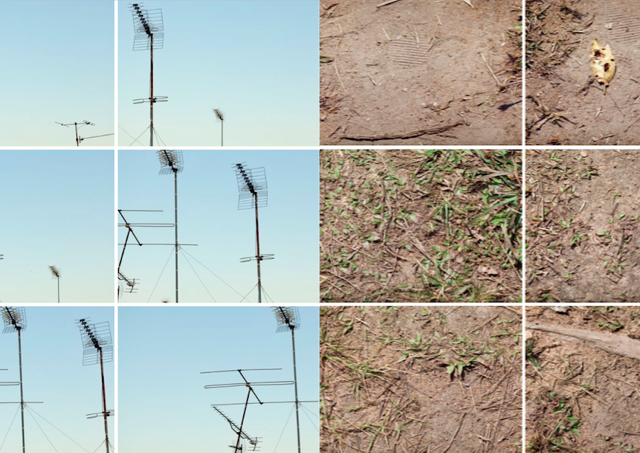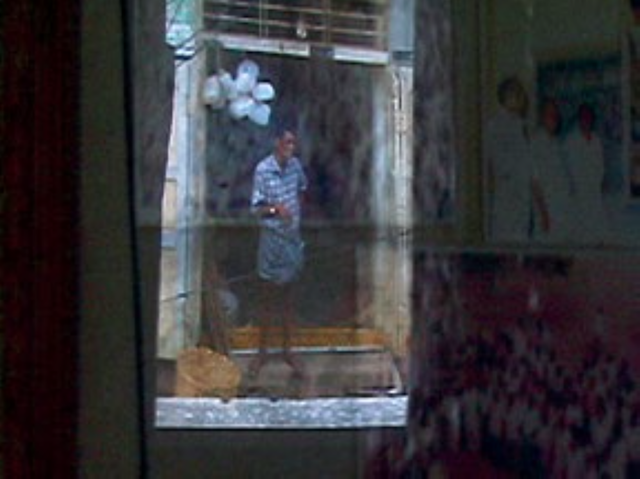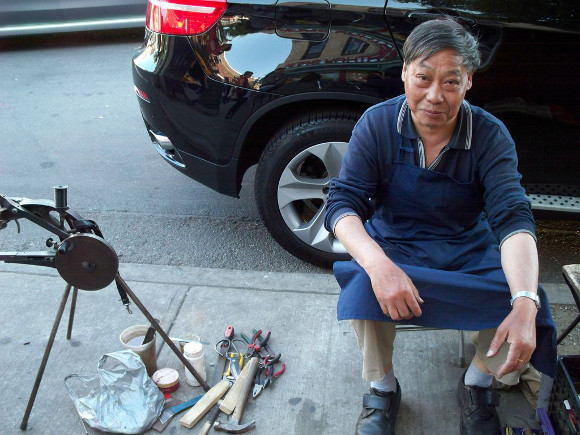Amarnath Ravva’s American Canyon gravitates between Northern California and South India as he reenacts rituals and shares histories of both his homes.

January 27, 2015
Under the Golden Gate Bridge in San Francisco, clay sculptures of the elephant-headed god, Ganesh, crumble in the brackish water—they are tributes from the Indian immigrant family of Amarnath Ravva. What do these sculptures have to say to their counterparts, 8,000 miles away in the Ganga in Varanasi, India? What might they learn from the bones and shells of California’s indigenous tribes, atop of which the clay figures reside? The two questions lead in geographically different directions, and Ravva’s memoir, American Canyon, is the product of his ambitious pursuit of both lines of inquiry at once.
A multimedia artist, writer, and performer, Ravva’s work is characterized by what we might call, after Edward Said, “contrapuntal” thinking. For Said, the contrapuntal emerged primarily from an awareness of cultural plurality, but Ravva’s attunement to “simultaneous dimensions” stems equally from his openness to a broad range of creative methods and aesthetics. He is part of the site specific, ambient improvisational ensemble Ambient Force 3000, and is also a curator at Betalevel, a performance venue in Los Angeles pitched as “part studio, part club, part stage, and part screen.” He has written and performed both fiction and nonfiction, and his poetry was included in the groundbreaking 2011 anthology of South Asian American poets, Indivisible.

American Canyon is in keeping with the experimental tenor of these earlier works. The book moves between Northern California and South India, mythology and memory, for its account of its author’s dual pilgrimages “home.” It unfolds in three parts—“Karma/Retribution,” “Maya/Illusion,” and “Atma/Spirit”—which introduce Ravva’s journey, his family’s beliefs, and the forces that transcend nationality and religion to bind the Indian American writer to both his Native American homeland in Benicia, California, and his roots in India. Beyond this division, there are no conventional chapters. Short passages of reflection and narration are often accompanied by a parallel image-text of video stills: a strip of three images, placed side by side as in a film reel, below the last line of text. The images on each particular page repeat with only slight variation: a palm frond moves in the wind; a flame dies down.
The book details Ravva’s journey to the holy town of Rameswaram on the Pamban Island in Tamil Nadu, where he, once an “adolescent atheist,” performs a “naga prathista” puja at his mother’s behest. The sections describing the puja comprise the book’s narrative present and are preceded by time stamps from a video camera. Ravva also recounts stories gleaned during an earlier trip to India, when he filmed twenty hours of oral history with family elders. Toward the close of the book, we learn that the backpack containing the film was stolen, and that many of the visuals we’ve been seeing do not actually coincide with the text alongside which they appear. The erasure of Ravva’s film—and its inevitable overwriting by whoever appropriated the tapes—thus appears to be the substantive loss to which the book responds.
This, to my mind, is the most fruitful way to read American Canyon: not as a text about the immigrant’s loss of an Indian homeland, but as a text about the writer-filmmaker’s loss of material footage, his laboriously and lovingly constructed archive, which is reduced once again to the memories it was supposed to replace. The Internet and mass-production of low-cost recording technologies have made witnesses of us all, so this is a loss to which the reader can easily relate: the missed candid; words unrecorded; videos languishing on phones that drop and shatter before they can be backed up. A generation ago, in the years following the 1965 Hart-Celler Immigration and Nationality Act, displacement from home was the fundamental shared experience of upwardly mobile, urbanizing Americans and immigrants alike. Today, we all share the documentary compulsion, and the means by which to satisfy it.

Ravva’s use of film stills follows the innovations of texts as different as Teju Cole’s Every Day is for the Thief (2007), in which the author’s photographs of Lagos are presented as having been produced during his narrator’s return-trip to Nigeria from New York City, and Theresa Hak Kyung Cha’s now-canonical Dictee (1982). Although Ravva’s text is not nearly as linguistically or theoretically inventive as Cha’s, Dictee is a revealing progenitor. Cha used historical images, hand-written text, maps, and even diagrams of the human body for what the literary theorist Anne Cheng has described as an “antidocumentarian” take on the politics of historical memory. Where Cha embraced Greek mythology as her own pre-history, Ravva turns to the Native Americans for an alternative genealogy against which to situate his inhabitance of American land and identity. Like Cha, Ravva employs a plurality of languages (Sanskrit, Telugu, and Maidu to Cha’s Korean, Latin, French, English, and Chinese) while striving to preserve his own singular voice. Cha’s text memorably opens with her frustrated attempt to take down a French dictation and “[mimick] the speaking.” Likewise, Ravva narrates what he is learning so deliberately (“a naga dosham is the result of prarabdha karma”) that you can hear him processing, internalizing, and defining the foreign words for himself.
But unlike Cha, whose text was strikingly disembodied (who was speaking, to whom, and from where?) and critical of the project of narrative self-disclosure, Ravva returns again and again to the body, his own and that of others. In one passage, he locates the dislocation of immigration in the America-accustomed flesh’s reaction to the elements of India: “Most Indians I know get sick when they return to India. Our cells have forgotten their early memories and need reminding.” In another, he describes his grandfather, Thathayya, unmoored from India and resigned to a chair in a California garage, where he sits next to a minivan, smoking and watching the rain. These are striking passages that foreground the corporeality and sensuality of inhabitance in a text that otherwise deals in familiar, psyche-focused terms with the well-worn issues of diaspora: longing for belonging, the inhabitance of nostalgia, and the affective disorientation of being in a new world. For example, Ravva describes the immigrant’s tendency to “[reconstruct] India within the confines of America” while her children strive to “hide what makes us different.”

In 2014, these descriptions are both terribly dated (this is water charted in both fiction and nonfiction by writers including Meena Alexander, Minal Hajratwala, Jhumpa Lahiri, Bharati Mukherjee, and more recently Akhil Sharma) and refreshingly matter-of-fact. Yes, that is what many of us did, isn’t it? We kept India alive. We were different: different from the normative Americans, different from our immigrant parents, different from each other, different from the children we were yesterday, different from the adults we would become. Some were proud about it, others self-conscious, and others still unmoved by communal identitarianism, preferring declarations of individual self-determination. And there was much we didn’t know about the America we made our own, including, as Ravva’s mother asks him in the book’s first section, “…who lived here before?”
The third section of the book responds to this question by juxtaposing Ravva’s Rameswaram pilgrimage with his exploration of Northern California, starting with a hike up Cemetery Hill in Quincy, where Chinese railroad workers lie buried. Walking up the hill, Ravva discerns “shapes in the trees,” which his friend Dave gives narrative form by recounting the history of the transcontinental railroad. “They used to live here,” Ravva answers his mother, referring not only to the Chinese, but also to California’s indigenous tribes: the Valley People, the South People, at Big Spring, Big Meadow, and Feather River. “Their dead, wrapped in bear hide, were buried under these homes,” he continues. “Beneath our carpet…could be the bones of a Patwin. They were southern Wintun, neighbors with the Maidu.” The names of the tribes are offered deliberately, even reverently, as Ravva goes on to demonstrate, without didacticism, the value of all histories: intimate and public, lived and recounted, official and unknown.
The rest of the book alternates between focusing on the Maidu Indians of California and the Madhwa Brahmins of India. Ravva matches statistics with anecdotes, and dispassionately recounts the chilling history of Maidu enslavement, the decimation of one people by the missionary zeal and mining claims of another. In more personal passages, he shows himself to be equally at home holding wormwood stalks for the Bear Dance as throwing ghee and rice into the sacred fire. Again, Ravva insists on the relation between embodiment and identification; what is at stake for him is not so much what he comes to know about his Indian family and Native American brethren, but rather who he is able to become by participating in the ritual practices of their daily lives.

To this end, American Canyon is strongest as a meditation on the nature and efficacy of knowledge, what in an academic idiom we might call the question of epistemology. How do we mark the gap between knowing and being, between being and becoming? What does it mean to have knowledge of something, to apprehend it, and to understand it? “Is it better to know or not know?” Ravva asks this question to an emailing, coke-drinking sadhu, Ganesh Puri, who he befriends at the Triveni Ghats. Puri is unhelpful, but Ravva offers his own provisional response to the question: “Knowing it does not matter.” There are two ways to read this line. First, there’s the reading that privileges the object of knowledge, “it,” transforming the line into, “knowing that it does not matter.” What does not matter? Everything, and nothing. The fact that Ravva’s father approves of pesticide use. The fact that his mother has painted a conspicuous “Om” on the garage doors of their suburban California home. The fact that the computerized horoscope generated for Ravva is in someone else’s name, details someone else’s stars. That he does not know how to pray. “I have nothing left to ask,” he says. It does not matter. Obligingly, he follows the instructions of the pujaris; he turns the harathi [sic] around the navagrahas, shows “devotion through rotations.”
Then, there’s the reading that troubles the premise of knowing itself: “knowing it, does not matter.” All the critique and every lie in the world, from the cry of Rachel Carson’s environmental treatise, Silent Spring, which Ravva’s father reads, to Colin Powell ill-fatedly “point[ing] at several canisters in the desert” in the aftermath of September 11th. It does not matter that Carson knows; it does not matter that Powell doesn’t. People will still get malaria; children will still be bombed; pujaris will still say prayers on your behalf. Knowing it, does not matter. It does not matter if the house Ravva’s mother designs in accordance with vaastu shastra, the Sanskritic system for holistically envisioned architecture, actually blocks spirits from entering their home. “[In] her psyche, in her narrative of herself, listening to her seer is the right thing to do.”

It sounds old-fangled in an America that prizes entrepreneurial “disruption” and striking out on your own over perpetuating the family business and listening to your parents, but American Canyon is ultimately about the value of doing right. Doing right by family, by country, by history—even if your initial efforts are thwarted by the stealing of a backpack, the deletion of a film. Ravva is there on every page, but rarely are we privy to his desires and beliefs. Instead, we see him doing his duty, asking the appropriate questions, making things right: “I try to understand what is being said,” he notes simply. “What is being hurled into the air around me.”
This effort extends beyond participating in his mother’s puja to the retelling of the history of the Maidu. That the Maidu’s story is not, at first blush, Ravva’s to tell strengthens the book’s message about responsibility: the history you learn, irrespective of from whom or from where it issues, is the history you must share. The book closes as Ravva carries 40 pounds of carved snakes to a temple, an offering that has been made for thousands of years. Ravva is not interested in breaking from tradition or critiquing its fetters; he is interested in its performance. His book is a testament to that commitment and to the piety that led to its fulfillment. “When [my mother] called,” he writes, “I said Yes.”



